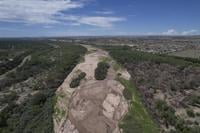ALBUQUERQUE, N.M. (AP) — A federal judge is being asked to issue a stop-work order on a $10 billion transmission line being built through a remote southeastern Arizona valley to carry wind-generated electricity to customers as far away as California.
A 32-page lawsuit filed on Jan. 17 in U.S. District Court in Tucson, Arizona, accuses the U.S. Interior Department and Bureau of Land Management of refusing for nearly 15 years to recognize “overwhelming evidence of the cultural significance” of the remote San Pedro Valley to Native American tribes including the Tohono O’odham, Hopi, Zuni and San Carlos Apache Tribe.
The suit was filed shortly after Pattern Energy received approval to transmit electricity generated by its SunZia wind farm in central New Mexico through the San Pedro Valley east of Tucson and north of Interstate 10.
The lawsuit calls the valley “one of the most intact, prehistoric and historical ... landscapes in southern Arizona,” and asks the court to issue restraining orders or permanent injunctions to halt construction.
“The San Pedro Valley will be irreparably harmed if construction proceeds,” it says.
Government representatives declined to comment Tuesday on the pending litigation. They are expected to respond in court. The project has been touted as the biggest U.S. electricity infrastructure undertaking since the Hoover Dam.
Pattern Energy officials said Tuesday that the time has passed to reconsider the route, which was approved in 2015 following a review process.
“It is unfortunate and regrettable that after a lengthy consultation process, where certain parties did not participate repeatedly since 2009, this is the path chosen at this late stage,” Pattern Energy spokesperson Matt Dallas said in an email.
Plaintiffs in the lawsuit are the Tohono O’odham Nation, the San Carlos Apache Tribe and the nonprofit organizations Center for Biological Diversity and Archaeology Southwest.
“The case for protecting this landscape is clear,” Archaeology Southwest said in that calls the San Pedro Arizona’s last free-flowing river and the valley the embodiment of a "unique and timely story of social and ecological sustainability across more than 12,000 years of cultural and environmental change.”
The valley represents a 50-mile (80-kilometer) stretch of the planned 550-mile (885-kilometer) conduit expected to carry electricity from new wind farms in central New Mexico to existing transmission lines in Arizona to serve populated areas as far away as California. The project has been called an important part of President Joe Biden's goal for a carbon pollution-free power sector by 2035.
Work in New Mexico after and resulted in the approval from the Bureau of Land Management, the federal agency with authority over vast parts of the U.S. West.
The route in New Mexico was modified after the U.S. Defense Department raised concerns about the effects of high-voltage lines on radar systems and military training operations.
Work halted briefly in November amid pleas by tribes to review environmental approvals for the San Pedro Valley, and in what Tohono O’odham Chairman Verlon M. Jose characterized as "a punch to the gut.”
SunZia expects the transmission line to begin commercial service in 2026, carrying more than 3,500 megawatts of wind power to 3 million people. Project officials say they conducted surveys and worked with tribes over the years to identify cultural resources in the area.
A photo included in the court filing shows an aerial view in November of ridgetop access roads and tower sites being built west of the San Pedro River near Redrock Canyon. Tribal officials and environmentalists say the region is otherwise relatively untouched.
The transmission line also is being challenged before the Arizona Court of Appeals. The court is being asked to consider whether state regulatory officials there properly considered the benefits and consequences of the project.
___
This story has been edited to correct the name of the San Carlos Apache Tribe. ___
Ritter reported from Las Vegas, Nevada.








































